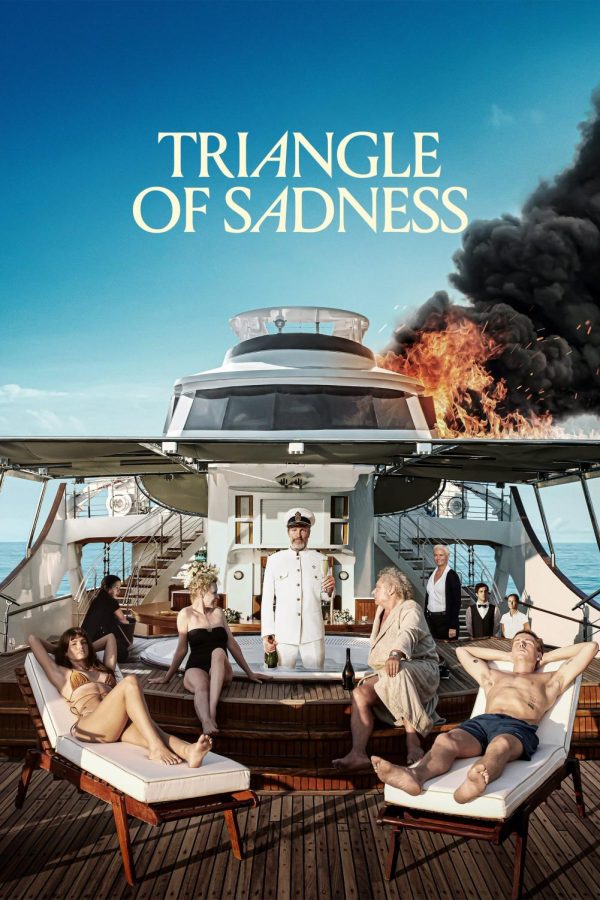“Triangle of Sadness” review: Ostlund’s comedy of errors
December 7, 2022
Swedish auteur Ruben Ostlund places his sociological microscope on the rich with his latest film “Triangle of Sadness.” While its brand of satire may feel less than subtle and doesn’t exactly pay off, its hilarious takedown of the wealthy elite and the subsequent blurring of class roles is a sight to behold.
The film is structured in three parts, each one more cumbersome than the other. The first part focuses on dating models Carl (Harris Dickinson) and Yaya (the late Charlbi Dean). They are essentially in a relationship of convenience, as one benefits from the other’s fame as social media influencers as well as good looks. Ostlund focuses on their gender dynamics as the two engage in a lengthy discussion over who should pick up the check during an awkward dinner date. It’s a worthwhile microcosm for the film’s razor-sharp focus on the way people behave in everyday situations, something that Ostlund has done to great effect in previous films such as 2014’s “Force Majeure” and the Palme d’Or-winning “The Square” (2017).
The second part is where “Triangle of Sadness” finds its satirical edge. As Carl and Yaya join a cruise for the super-rich, Ostlund introduces the viewer to an eclectic cast of wealthy characters. There’s the vulgar yet charismatic Russian oligarch Dimitri (Zlatko Buric) and his wife Vera (Sunnyi Melles) and the elderly couple Clementine (Amanda Walker) and Winston (Oliver Ford Davies), who made their fortune manufacturing weapons. There’s also timid tech bro Jarmo (Henrik Dorsin) who comes alive with female company, and a German woman named Therese (Iris Berben) who is only capable of speaking a single sentence following a stroke (which becomes a running gag for the rest of the film). Catering to their overall absurd requests is the hapless head of staff Paula (Vicki Berlin), who also becomes saddled with taking care of the always drunk ship captain Thomas (the effortlessly chaotic Woody Harrelson).
Ostlund turns up the mischief in the film’s centerpiece, where the guests gather for a luxurious dinner in the middle of a storm at sea. They are served superficial food (compared to the captain’s burger and fries) that turns out to be spoiled, resulting in everyone puking their guts out. Ostlund tilts the camera back and forth in a way that also subconsciously invites the viewer to vomit with them as well, which may account for the promotional barf bags provided at some screenings of the film. As the ship’s toilets back up, the PA system blares out drunken philosophical arguments, and pirates surround the ship, it’s literal Hell for everyone involved.
The film’s third section is where everything winds down to a screeching halt. The survivors escape to a seemingly deserted island, where they submit to lowly cleaner Abigail (the scene-stealing Filipina actress Dolly de Leon), who has survival skills they lack. While the last section of the film is initially engaging in terms of depicting how the status quo between the haves and the have nots become upended, it bites off more than it can chew in its alarmingly one-sided hatred for the rich. Of course I want to see these obscenely rich people get their deserved comeuppance, but after a while it becomes clear that Ostlund treats them as concepts rather than richly detailed people.
Still, it’s all in good fun for Ostlund and company, as it’s singularly entertaining as a social satire. I just find it ironic that it won this year’s Palme d’Or, as its arthouse trappings must have entranced the Cannes jurors. Ostlund’s brand of satire feels shallow compared to the likes of Michael Haneke and Lars von Trier, but the way he frames this sense of discomfort feels amusing at the same time; just don’t take it too seriously. “Triangle of Sadness” may state the obvious in a miasma of vomit and feces that seems so juvenile, and yet you can’t look away.
“Triangle of Sadness” is now available in theaters.









